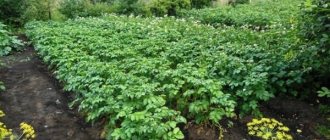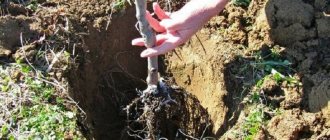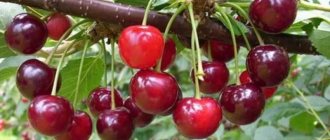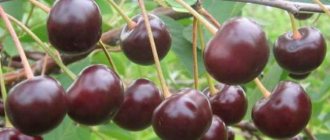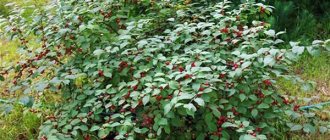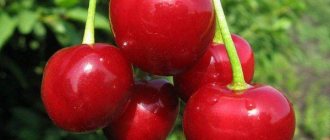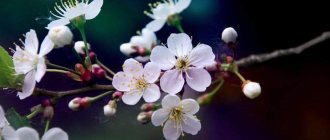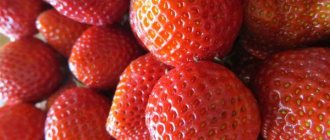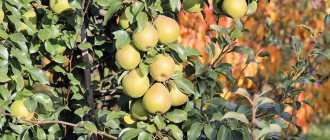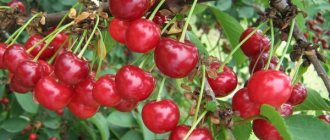Description of Zhivitsa cherry
The plant has an almost straight trunk and a rounded crown, slightly elongated from bottom to top. The density of the branches is average, the foliage is high. The branches are raised and sagging. The color of the trunk is brownish-gray.
The leaves have an elongated shape. Their sizes are about 12 cm in length and 3-4 in width. Color – rich green. Most of the buds are formed on the shoots of the current year.
The flowers are small and white. The flowering period begins in mid-May. The variety is self-sterile, that is, fruiting without pollinators will be practically absent.
Top of the crown of the Zhivitsa cherry
The variety is classified as early ripening and winter-hardy. Recommended for cultivation throughout Belarus and Ukraine, as well as in central Russia. However, due to its good frost resistance, it adapts well to colder regions. There is numerous evidence of the successful cultivation of Zhivitsa cherries in the regions of the Urals and Western Siberia.
The hybrid has also adapted in the South. It is successfully grown in the North Caucasus and the Astrakhan region, although it has no commercial importance in these regions, since more productive heat-loving varieties can be grown in them.
Dimensions and height of Zhivitsa cherry
The diameter of the plant trunk rarely exceeds 10-12 cm. The rounded crown measures from 1.5 to 2.5 m. The height of the Zhivitsa cherry can range from 2.5 m to 3 m.
Description of fruits
Zhivitsa cherry berries are round in shape and medium in size. Their weight does not exceed 3.7-3.9 g. They have relatively fragile, delicate skin of a dark red color. The pulp of the hybrid is dense, but at the same time very juicy. It has the same color as the skin. The stone is small in size, freely separated from the pulp.
Ripe Zhivitsa cherry fruits
The taste is rated as very good, approaching excellent. There is a barely noticeable sourness in it. On a five-point scale, the taste of Zhivitsa cherry is rated at 4.8 points. The use of fruits is universal; they are consumed raw and processed. When preserved, they perform well, do not wander or explode.
Pollinators for Zhivitsa cherry
All cherry-cherry hybrids do not yet have self-fertile specimens. This is a serious problem for breeders, which they have been struggling with for decades. Cherry Zhivitsa was no exception. In addition, it does not have the possibility of cross-pollination with its own variety or related ones. For this purpose, all Dukes need only parent cultures.
The previously mentioned Griot and Denisenu can be used as a pollinator, but the use of closely related varieties is also acceptable. These include: Seedling No. 1, Novodvorskaya, Vyanok.
As a last resort, you can try to pollinate with an unrelated crop. Any variety that blooms around this time (1-2 decades of May) is suitable for this task. It is possible that it will be possible to find a previously unknown effective pollinator for the Zhivitsa cherry.
Attention! The greater the varietal diversity of cherries in the garden, the greater the likelihood of successful fruit set of the hybrid in question.
According to gardeners, the minimum required number of pollinating varieties for Zhivitsa cherry should be 3-4.
Gift for teachers
The variety was obtained from artificial crossing of the Lyubskaya x Orlovskaya rannyaya varieties. Originator: All-Russian Research Institute for Breeding Fruit Crops. Authors: A.F. Kolesnikova, E.N. Dzhigadlo, A.A. Gulyaeva, A.V. Zavyalova. In state variety testing in 2003.
The tree is medium-sized, up to 3 m high. The crown is wide-rounded, spreading, raised, of medium density. The shoots are medium, straight, brown. The bark on the trunk and main branches is brown and smooth. The bud is 4.0 mm, ovoid, slightly deviated from the shoot. The leaf is ovoid, dark green. The apex is pointed, the base is sharp, the edge is serrated. The surface of the leaf blade is smooth, matte, flat. Glands 2-3, located at the base of the leaf blade and on the petiole. The petiole is 17.0 mm long, 1.9 mm thick, pigmented (with anthocyanin coloring) along its entire length. Fruits on last year's growth and on bouquet branches.
Fruits weighing 4.1-4.5 g, round in shape, height 16.0 mm, width 15.0 mm, thickness 16.0 mm. The funnel of the fruit is wide, deep, the apex of the fruit is round, elongated, slightly depressed. The stalk length and thickness are average. The stone is round, weighing 0.24 g, which is 5.85% of the weight of the fruit, and is easily separated from the pulp. The fruits are dark red. The pulp is red, medium density, juicy, red juice. Tasting score of fresh fruits: 4.3 points. Table variety. The fruits contain dry matter - 18.2%, sugars - 11.9%, acids - 1.0%.
Flowering in the middle period (May 15-20). Fruit ripening early (July 1). It begins to bear fruit in the 4th year. The durability of trees is high in compliance with production technology. The variety is partially self-fertile. The average yield is 53.3 c/ha, the maximum is 57.3 c/ha. It is characterized by high winter hardiness of the tree and flower buds. Coccomycosis and moniliosis are affected to a moderate degree.
Advantages: stable yield, early ripening.
Disadvantages: does not have high resistance to fungal diseases.
Main characteristics
The hybrid has high performance characteristics. This is one of the most profitable varieties for growing in cold climates, although some gardeners note the average yield of the variety. On the other hand, this indicator is quite acceptable for a frost-resistant crop with fruits of similar quality.
Drought resistance, frost resistance
The variety is highly drought-resistant. Moreover, frequent watering is not recommended. Moisture should be added to the Zhivitsa cherry only when there is a critical lack of moisture. The root system of trees is very powerful and can penetrate to a depth of several meters.
Important! However, trees up to 3-4 years of age do not yet have such a system and need regular (every 10-15 days) watering.
The frost resistance of the variety is high. The tree is able to withstand winters with temperatures dropping to -25 °C. In the conditions of the Middle Zone, in Belarus and Ukraine, no freezing was observed even in the most severe winters.
Productivity
The Zhivitsa cherry hybrid ripens in mid-summer. Fruiting dates begin at the end of June or in the first ten days of July. The variety is fast-bearing - already in 3-4 years of life you can reap abundant harvests.
The yield, even with minimal care, is about 100 kg per hundred square meters. With proper application of fertilizing and compliance with planting agricultural techniques, record figures are about 140 kg from the same area. On average, one tree produces about 12-15 kg of fruit.
The scope is universal. They are used for making juice and compote, as a filling for baked goods. When preserved, despite the relatively soft skin, the fruits retain their integrity. The transportability and keeping quality of the variety are satisfactory.
Advantages and disadvantages
The positive qualities of the Zhivitsa cherry hybrid include:
- high productivity;
- excellent taste of the fruit;
- versatility in application;
- precociousness;
- winter hardiness;
- resistance to most diseases;
- good bone separation.
Disadvantages of the variety:
- the need for several varieties of pollinators.
The history of Duke Zhivitsa
The Zhivitsa variety (according to the originator - Zhyvitsa) appeared at the Belarusian Research Institute of Horticulture. Scientists E. P. Syubarova, P. M. Sulimova and M. I. Vyshinskaya crossed the following representatives of two cultures:
- Known since the end of the 18th century, the Griot Ostheim cherry (presumably originally from Spain), which became the parent form of many varieties. Its selection-significant characteristics are early fruiting, productivity and good taste.
- Denissena yellow cherries (in the sources there is a variant of Denissena yellow) with rather large yellow tasty fruits and a good level of frost resistance. The variety was bred in Germany in the first half of the 19th century.
Since 1990, Zhivitsa has been under state variety testing, and in 2002 it was approved for cultivation in the Central region. The variety was included in the State Register of the Republic of Belarus in 2005.
Landing rules
Planting Zhivitsa cherry does not have any special features. Recommendations may only relate to the timing of planting and the placement of trees on the site. The remaining points (depth of the hole, applied fertilizers, etc.) are standard for cherries in a temperate climate.
Recommended timing
It is recommended to plant Zhivitsa cherry in the spring. Autumn planting is not prohibited, but in this case the seedling must be completely protected from frost using heat-insulating material.
Important! The heat-insulating layer must allow air to pass through.
Site selection and soil preparation
There are no special requirements for site selection and soil quality. Cherry Zhivitsa grows well in any type of soil. The only important recommendation is that the site should be sunny.
Cherry seedlings Zhivitsa
To obtain good yields, a planting pattern of 3 m by 5 m is recommended. In this case, the trees can be placed either in even rows or in a checkerboard pattern.
How to plant correctly
The planting algorithm is standard: seedlings 1-2 years old are placed in holes with a diameter of 60 cm and a depth of 50-80 cm. Up to 2 buckets of humus are placed at the bottom of the hole, which is placed in a slide.
A peg is driven into the center of the hole, to which the seedling is tied. Its root system is evenly distributed along the slopes of the hill, sprinkled with soil, compacted and watered with 20 liters of water.
It is recommended to mulch the trunk circle with a layer of sawdust or freshly cut grass for the first two years after planting.
Harvest and storage
Cherry berries begin to ripen in mid-July - early August, and this is when the harvest should take place. For long-term storage, fruits should be removed from the branches along with the stalks and placed in soft, clean, dry containers, like wooden baskets or fabric-lined boxes.
The most comfortable conditions for preserving cherries are:
- dry, well-ventilated, clean room;
- air temperature 0…+5°С;
- relative humidity 80–90%.
Important! Fruits collected early in the morning have the greatest nutritional value. Also, such berries can last longer.
Under such conditions, cherries are able to retain their presentation and taste for two weeks.
Harvesting must be done carefully so as not to damage the fruits.
Harvesting must be done carefully so as not to damage the fruits.
Zhukovskaya cherry, thanks to its high technical characteristics, excellent fruit quality and ease of cultivation, has remained one of the most beloved varieties cultivated by domestic gardeners for many decades. The crop is able to please with consistently high yields, while requiring fairly standard care, which consists of timely watering, fertilizing and pruning.
Features of care
Caring for Zhivitsa cherries is standard. This includes infrequent watering, fertilizing in poor soils and regular pruning at the end of the season.
Watering and fertilizing schedule
Watering is done more often than once every 2-3 weeks, since the root system of adult trees is branched. If there is a sufficient level of precipitation, artificial irrigation may not be necessary at all.
Feeding is done twice per season:
- in early spring - nitrogen components (no more than 20 g per tree);
- at the end of autumn - superphosphate and potassium fertilizers (30 and 20 g per plant, respectively).
Trimming
It forms a crown on its own, so it does not need any specific pruning. However, it is believed that the further north the growing area, the shorter the height of the tree as a whole. In very cold regions (with winters when the temperature drops to -30 °C), it is recommended to form a trunk and crown in a bush-like form.
The crown is too thick, requiring regulatory pruning
Other types of pruning (sanitary, thinning and stimulating) have no special features; they are performed as needed.
Preparing for winter
The Zhivitsa cherry variety does not require any special procedures in preparation for wintering. It is recommended to carry out sanitary pruning at the end of October and whiten the trunks to protect them from rodents.
Harvest and storage
Fruiting of Volochaevka begins in the 4th year of life. An adult tree produces a harvest of up to 15 kg.
Cherry is not a crop whose fruits are picked prematurely, since the berries do not ripen, remaining sour. You can’t let it overripe, otherwise most of the fruits will fall off and rot. In the southern regions, the berries ripen in early July, in the central regions - in the middle of the month, and in northern climates - at the end of July.
The collection is carried out in dry weather, in the morning or evening, when the sun is not too active. For storage or transportation, cherries must be collected together with the stem or part thereof. For further processing, the fruits can be picked without the petiole. In this case, you need to take into account that the berries will only be stored for 2-3 days, and then they will begin to deteriorate.
Important! 2 weeks before the expected harvest, you should not water the trees, otherwise the fruits will be watery.
If the cherries are harvested during a rainy period, most likely the berries will be sour and their shelf life is much shorter. It is better to process such a harvest for winter harvesting.
For storage, fruits with petioles are placed in wooden boxes and placed in a dry room at a temperature of 0...-2°C and air humidity at 90%.
The Volochaevka cherry variety is worthy of the attention of farmers: it has excellent taste characteristics, high annual yields and many other advantages. Even a beginner in gardening can cope with growing crops.
Diseases and pests
Cherry Zhivitsa has good disease resistance. However, it is recommended to carry out regular measures to counteract diseases such as coccomycosis and moniliosis.
Cherry coccomycosis
These measures include regularly digging up the soil at the beginning and end of the season, as well as destroying dry grass and leaves in late autumn. It is recommended to spray trees and soil in the tree trunk with copper-containing preparations;
- copper chloroxide 0.4%;
- Bordeaux mixture 3%;
- copper sulfate 4.5%.
These measures should be applied during kidney swelling.
Video: practical tips for growing cherries
Cherry Zhivitsa is a new variety. The main experience of its cultivation has been accumulated in Belarus, and in Central Russia it has spread to few places and only recently, so there are still few reviews in sources about this variety. But judging by the descriptions - unpretentiousness, endurance and resistance to frost and disease, quick return of the first harvest - it has good prospects. Therefore, the one who lands it first can win. Moreover, it is planted for normal pollination along with other varieties that have already shown themselves to be good.
- Author: Gennady Chernikov
Rate this article:
- 5
- 4
- 3
- 2
- 1
(1 vote, average: 5 out of 5)
Share with your friends!
Advantages and disadvantages
Lyubskaya cherry is one of the best technical varieties, the main advantages of which are:
- high percentage of self-fertility;
- flowering occurs at the end of May, so flowers and ovaries are not damaged by spring frosts;
- By providing these fruit trees with appropriate care, you can achieve high yields from the variety;
- the sparse crown and miniature size make it easier to care for the branches and collect ripe fruits;
- even if the care is not very good, the fruiting of the Lyubskaya cherry is still quite high;
- easy to separate the seeds from the pulp;
- the harvested crop tolerates transportation well over long distances and is stored in a cool place for a long time;
- the fruits easily move away from the stalks, but do not fall off;
- ripe fruits are quite large.
This cherry has few disadvantages:
- poor resistance to fungal diseases;
- in regions with a harsh climate, this cherry does not grow without additional shelter;
- fruits are too sour;
- The trunks of this variety often suffer from sunburn.
Diseases and harmful insects
Diseases and harmful insects affect the Zhivitsa variety to a small extent, like most hybrids.
This cherry crop is not affected by either coccomycosis or moniliosis. It is from these diseases that cherries have been suffering lately.
There are also varieties that are immune to coccomycosis: “Tsarevna”, “Shalunya”, “Ashinskaya”, “Fairy”.
In very rare cases, aphids attack a tree. And birds do little harm to this variety compared to other cherry varieties.
The high marketability, excellent taste and ease of care of the Zhivitsa variety allow it to be widely used in private garden plots and on an industrial scale.
Due to its frost resistance, this hybrid crop can be grown further north.
Also undemanding varieties are: “Griot Moskovsky”, “Igrushka”, “Lyubskaya”
Reviews
Zhivitsa cherry is often recommended for planting as the most delicious and productive variety. Those who have been growing this variety for many years know that the berries always grow in sufficient quantities, and their taste is amazing. It is recommended to prune cherries at least once a year. There are not many young shoots that form near the tree; it is also recommended to pull them out at the very beginning of their formation. For abundant fruiting next summer, during the first flowering it is recommended to pick off all the inflorescences from the bushes. Even in cold summers and insufficient sun, the tree actively bears fruit, so there will be a harvest in any case. Those who breed cherries on an industrial scale also praise the variety for its early ripening and excellent transportability of the fruit.
sibay-rb.ru || Dionysius origin of the name. The meaning of the name Dionysius, when is Dionysius’ name day
The Zhivitsa variety is recognized as one of the best hybrid varieties of cherries. Easy to care for, does not require much space for planting, unpretentiousness to soil and weather - these are the strengths that make this variety a must-have for growing.
Description and characteristics of the variety
Resin is characterized by several important properties:
- she is unpretentious;
- frost-resistant;
- it is easy to care for;
- cherry can grow even in harsh Siberian conditions;
- resistant to coccomycosis;
- not affected by monilial burn;
- has strong immunity to pests.
The main thing is to properly organize the planting and care of this crop. Every gardener can cope with this task. And then the cherry will delight you with its high fruitfulness and beneficial properties. Berries, leaves, stalks, and roots of the bush can be used not only in canning, but also as medicine.
Agricultural technology
In order for a cherry orchard to bear fruit for a long time, it is necessary to take care of it: feed it on time, water it, prune it and take preventive measures against pests.
Watering and loosening
Cherry is a relatively drought-resistant plant that requires moderate regular moisture. At first, trees planted in spring should be watered 1–2 times a week, 30 liters per plant. Then less often, once a month is enough. For a fruit-bearing tree, the norm is 5–7 buckets:
- in the green cone phase;
- after flowering;
- during the period of ovary formation;
- after harvest.
With a lack of moisture at the beginning of the growing season, foliage grows weakly, during the flowering period the ovaries form sluggishly, and during fruiting the mass of berries decreases.
Watering after harvest is also very important. For better wintering in dry autumn weather, water-charging watering must be carried out. The soil is moistened to a depth of 40 cm, using at least 80 liters per 1 m2.
When sprinkling, not only the soil, but also the entire crown is well moistened
Cherries are watered by adding water to the irrigation grooves, by sprinkling, or using a drip irrigation system.
- Drip irrigation is carried out using tapes with droppers into which water is supplied under pressure. This allows you to maintain the necessary soil moisture and also significantly reduces water consumption.
- To water fruit trees by sprinkling, hoses with sprinklers are used, which moisturizes not only the roots, but also the crown, which is especially important in hot, dry weather.
- Summer residents more often use irrigation along grooves that are made around the trunk and bring water into them. After absorbing moisture, the furrows must be sealed.
When the berries ripen, do not water them to avoid cracking.
The tree trunk circle should be kept clean. It is necessary to remove weeds, loosen the soil to a depth of 10 cm, and mulch the tree trunk with hay and straw.
The soil under the crown must be loosened to provide air access to the roots
Feeding
Fertilizing provides a large harvest and increases plant immunity. Fertilizers are applied in the 2nd year of planting.
- At the beginning of the growing season, for accelerated growth, young trees are fed with nitrogen fertilizers (30 g urea/10 l).
- Before flowering, in calm weather, spray the crown with Ideal (5 ml/5 l).
- In September, feed with phosphorus-potassium solution (2 tbsp/10 l).
When fruiting occurs, fertilizer rates are increased by 1.5 times.
- In early spring, urea (120 g/1 m2) is scattered over the surface along the periphery of the crown projection for loosening or before rain without embedding into the soil.
- In the green cone phase, superphosphate (50 g/10 l) is added, after the petals fall - nitrophoska (50 g/10 l).
- At the end of the season, the tree trunk circle is mulched with humus.
- Once every 5 years, the soil is deoxidized with lime (500 g/1 m2).
Complex fertilizer helps accelerate ripening and improve the quality of berries
By the appearance of the tree you can determine what elements it needs. Iron deficiency is indicated by premature leaf loss. With a lack of boron, the leaves become deformed and dry out. A lack of copper can be judged by small brown spots on the leaf blades. If the leaves become smaller, it means the plant lacks zinc.
Root feeding should be combined with foliar feeding. During the season, the foliage is sprayed several times with an interval of 2 weeks with Agricola (50 g/10 l), Zdraven-aqua (35 ml/10 l), which stimulate plant immunity, have an anti-stress effect, and create good conditions for fruiting. During flowering, for better pollination, the tree can be sprayed with a solution of boric acid (1 g/10 l), adding 100 g of honey to attract bees.
In spring it is useful to spray the crown with urea
Gardeners recommend removing some of the fruits at the greenfly stage; the remaining ones will be noticeably larger and tastier.
Gardeners with many years of experience prefer to combine organic and mineral fertilizers. In the spring, when the crop needs nitrogen, mullein (3 kg/30 l) or chicken manure (2 kg/30 l) is added, and ash (300 g/1 m2) is added before fruiting.
Trimming
Without regular pruning of cherries, high yields cannot be expected. By slightly cropping annual shoots and bouquet branches, branching is stimulated, but too much shortening leads to weakening of the branches. When thinning, remove broken, dried and inward branches. They are cut off completely, the sections are treated with varnish. Root shoots are removed regularly.
Cherry pruning promotes tree longevity and increased yield.
During the first 5 years in early spring, with the help of pruning, a crown is formed, usually in a sparsely tiered type, laying up to 10 skeletal branches. Immediately after spring planting, the trunk is shortened to 75 cm. When planting in autumn, this is not recommended; it is better to postpone it until spring. At the beginning of the second season, the branches on the bottom row are cut off, leaving the 3 strongest ones, cut them off by 1/3. The central shoot is cut at a level of 1 m from the bottom row. During spring pruning in the 3rd year, a second tier of 3 shoots is formed, the conductor is shortened at a height of 1 m from the second row. For the next season, 3 branches are left in the last (third) tier.
In the first 5 years, formative pruning is carried out
Over time, the yield decreases and the tree requires rejuvenating pruning. Old skeletal branches and branches are replaced with healthy lateral branches.
Video: features of cherry pruning
Preparing for winter
Zhivitsa is a frost-resistant variety, but in normal winters with long thaws, flower buds may freeze. Therefore, trees should be prepared for the cold. After the end of the growing season, the trunk must be whitened. Due to temperature changes on a sunny day with thaw and frost at night, the bark may crack without protection.
In the pre-winter period, the soil around the perimeter of the crown is loosened and well moistened to a depth of at least 50 cm. This way the ground freezes more slowly, and the roots of the trees do not suffer from cold shock and winter easier. Well-watered soil is covered with sawdust. It would also be useful to cover the trunk and skeletal branches with non-woven material, especially in young trees.
To avoid damping off, insulate the cherries in settled cool weather (00C). When the temperature rises to 50C, the shelter is removed.
For the winter, young trees must be covered with non-woven material.
Spring frosts during flowering also hit the harvest. Buds die at a temperature of -40C, flowers -20C, ovaries -10C. Such cold snaps are especially dangerous when the temperature during the day is 6–100C, and at night it drops to minus levels. Fan watering (50–80 l/tree), spraying the crown with water, and smoking can mitigate the damage from returning May frosts. Treatment before and after frost with stimulants (Epin), which significantly increase the resistance of plants to low temperatures, also helps.
Disease Prevention
Resin has a high immunity to infections, however, even such a resistant variety, especially in young plantings, can be affected by diseases.
Table: cherry diseases
| Diseases | Symptoms | Prevention | Treatment |
| Clusterosporiasis | Spots appear on the foliage, and subsequently holes form in their place. The leaves are drying up. The development of a fungal disease is promoted by bush thickening and high humidity. |
| Treat with 1% Bordeaux mixture (100 g/1 l) before and after flowering, again after 2 weeks. |
| Gray rot | The disease develops in damp weather. Gray growths appear on the shoots, and the fruits begin to rot. |
|
|
| Anthracnose | Cherry fruits become stained, shrink and mummify. Rainy weather favors the development of the disease. |
| Before the buds emerge, spray with Nitrafen (300 g/10 l). |
Photo gallery: signs of cherry disease
When you become infected with clasterosporiosis, rounded light brown spots appear on the leaves; after a week, the affected tissue dies and falls out
Infection with gray mold often occurs in rainy spring with fogs
With anthracnose, the fruits become stained and dry out.
Flocks of birds can instantly destroy most of the berries. To protect the crop from birds, special nets are thrown over branches with ripe fruits.
Table: insect pests
| Pests | Manifestations | Prevention | Measures |
| cherry fly | Larvae, feeding on fruit pulp, can damage up to 70% of the crop. |
| After flowering, spray with Iskra (1 ml/5 l), Aktara (2 g/10 l), again after 7 days. |
| Slimy sawfly | The larvae gnaw out the pulp of the leaf, leaving only the veins. |
| Treat with Aktara (2 g/10 l), Calypso (2 ml/10 l) repeatedly during the growing season, but no later than 20 days before harvest. |
| Weevil | Beetles eat buds and leaves. |
| Spray in the green cone phase with Fufanon (10 g/10 l). |
| Aphid | Aphids inhabit leaves and stems, feeding on their sap. Young shoots dry out and die. |
|
|
Photo gallery: insects threatening cherries
A shiny black small fly, 5 mm long, lays eggs in fruits
Slimy sawfly larvae feed on the pulp of leaves, leaving only the veins
Weevils feed on buds and young leaves
Aphids cause especially great harm to young gardens.
Top 5 sweetest cherry varieties
Many people are accustomed to the fact that cherries are sour. But not everyone knows that there are varieties with very juicy and very sweet fruits. Try them - and you will forever change your attitude towards cherries for the better!
Amorel Nikiforova
A cherry tree that is of medium size in height. The fruits are small, light red in color. The taste is sweet and sour. The variety is insensitive to frost.
- fruit trees do not require regular watering;
- resistant to periods of drought;
- have high resistance to low ambient temperatures;
- This fruit tree is self-fertile.
